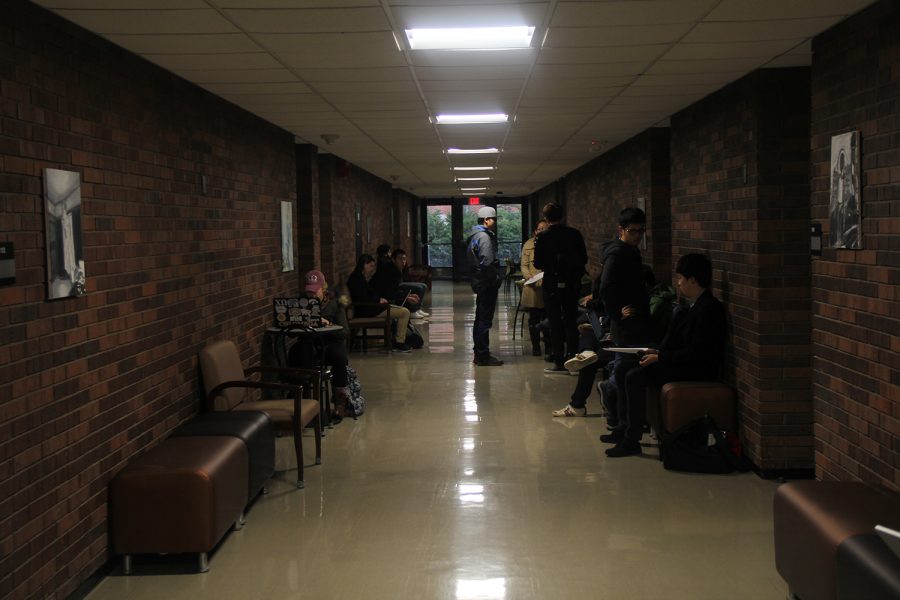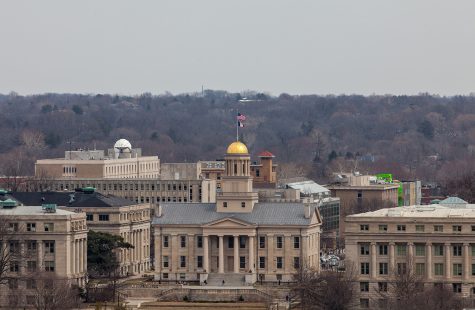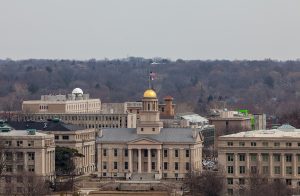Opinion: The English-Philosophy Building needs to be improved
As a City of Literature, our writing programs deserve to be housed in a suitable building.
Student made paintings are shown inside the EPB on Wednesday, Dec. 2, 2015. Students from the art department moved these paintings to the EPB in attempt to make the building less bland.
October 10, 2019
The habitat of the English and Creative Writing student at the University of Iowa can be marked by two buildings: the English-Philosophy Building, which stands beside the Iowa River and the Dey House, tucked away at the north end of Clinton Street. Both have been the setting for the writers who have made Iowa City an UNESCO City of Literature for over half a century. It’s to be expected that the University of Iowa would prioritize all of its buildings dedicated to literature and writing. This is not the case with the EPB.
The Dey House is 1850s Victorian-styled, carefully renovated home, a nest for the prestige of the Writers’ Workshop M.F.A. candidates. Its rooms and halls that lead to the Glenn Schaefer Library are filled with light and character.
By considerable contrast, the EPB, with a gloomy exterior of patterned red brick, is the center for the UI undergraduate students, as well as the Nonfiction Writing Program. The building is over a century older than the Dey House, and its expired interior designs reveals an indifference by the UI.
Undergraduate students and nonfiction-writing masters’ candidates should be able to pursue their education in a building created for them that at least has proper air conditioning, heating systems, and plenty of natural light. The EPB, like the Dey House, should be a reflection of the pride the UI has for its students who have chosen this university to pursue and expand their talents and skills in creative writing and literature. Instead, it is a reflection of neglect.
The detailed beauty of other liberal-arts buildings such as the Voxman Music Building and the two art buildings’ architecture manifests the UI’s care for these undergraduate programs. Their designs represent the field being studied and create a space that best nurtures students pursuing a field in the arts. Each are well-equipped with studios, practice rooms, and other amenities, an elaborate environment that has been designed specifically for its creative students.
But it is writing in particular that is the identity of the UI and Iowa City. How can the university make evident investments towards its few chosen graduate candidates, but neglect its undergraduates, who make up the vast majority of the departments? The EPB barely functions as a building alone. It offers little presence worth inspiring like the Dey House does, reminding its writing and literature students of why Iowa City is named a City of Literature.
The UI needs to increase its investment in improving the EPB altogether, just as it has with the Dey House in its renovations.
It makes sense that as the reputation of Iowa City’s writing programs have risen through the decades, that funding too would rise. But these writing programs are not just the Writers’ Workshop. Not all of Iowa City’s great writers are going to become novelists or poets who will spend two years writing, revising, and producing work from the Dey House. Most of them are waiting for their next class in dim hallways or workshopping in overheated classrooms with windows that can’t open.
By changing this atmosphere through better financial funding towards the EPB, the UI will better nurture the image and reputation it has built as a city of writers, ultimately giving its undergraduate and nonfiction-writing students a proper home.
Columns reflect the opinions of the authors and are not necessarily those of the Editorial Board, The Daily Iowan, or other organizations in which the author may be involved.





















